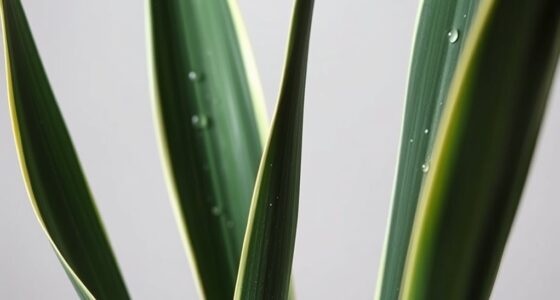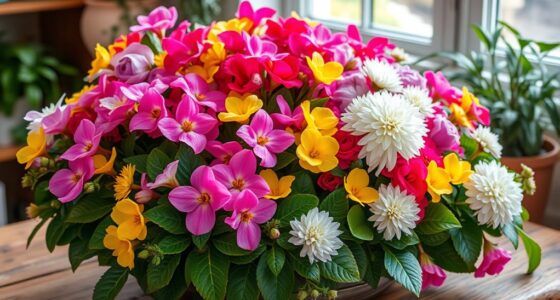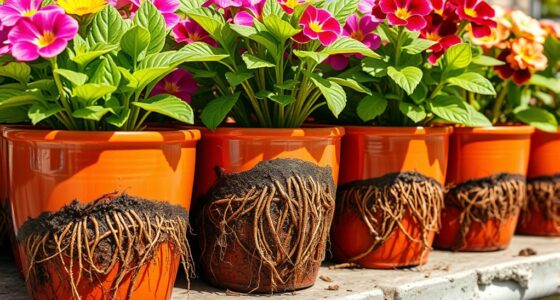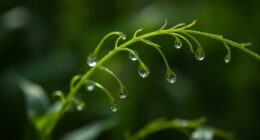To avoid mold, consider using open terrariums, which let excess moisture evaporate and reduce humidity, or guarantee you’re careful with watering in closed systems. In closed setups, regular ventilation and not overwatering are key to prevent mold growth. Both systems can stay healthy if you balance moisture, airflow, and plant choices. Want to discover more tips on keeping your terrarium mold-free? Keep exploring to find out how to best care for your plants.
Key Takeaways
- Open terrariums promote airflow and moisture evaporation, reducing mold risk compared to closed systems.
- Closed terrariums require careful moisture monitoring and periodic ventilation to prevent mold growth.
- Well-draining soil and avoiding overwatering are essential for mold prevention in both system types.
- Regular cleaning and removing decayed plant material help minimize mold spores.
- Choose plants suited to the humidity level of the system to reduce mold development.
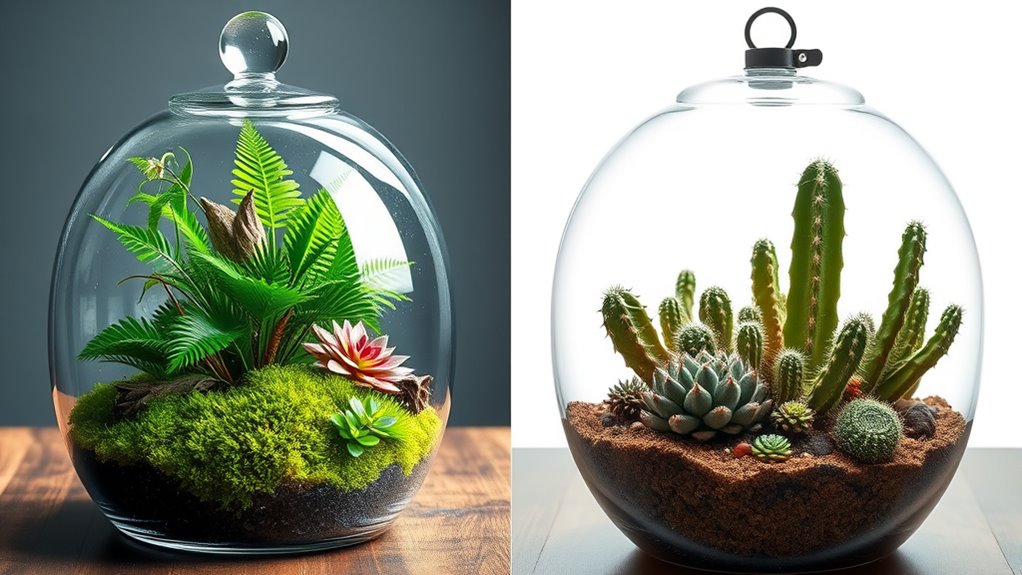
Terrariums are popular mini-ecosystems that bring greenery into your space, but choosing between closed and open systems considerably impacts how your plants thrive. When it comes to avoiding mold, understanding these systems is vital. Closed terrariums trap moisture inside, creating a humid environment perfect for certain plants, such as ferns or mosses. However, this high humidity can also foster mold growth if not managed carefully. If you tend to overwater or leave the lid on constantly, mold can quickly take hold, turning your lush miniature landscape into a fuzzy, undesirable mess. To prevent this, you need to monitor moisture levels closely and guarantee proper airflow—sometimes opening the lid occasionally or removing it altogether to let excess humidity escape. Using well-draining soil and avoiding overwatering helps keep mold at bay, especially in closed systems.
Closed terrariums trap moisture, fostering mold; monitor humidity and ensure airflow to keep your plants healthy.
Open terrariums, on the other hand, allow excess moisture to evaporate freely, making mold less likely. Because they are exposed to air, these systems typically stay drier, which discourages mold growth altogether. If you’re worried about mold, an open design might be your best bet. You can still create a lush, attractive display without risking too much moisture buildup. Just remember that plants in open terrariums may require more frequent watering since they tend to dry out faster. The key is balancing watering habits with proper airflow—watering only when the soil feels dry and ensuring good ventilation. This approach minimizes the chances of mold developing while keeping your plants healthy. Additionally, air circulation in your terrarium environment plays a critical role in mold prevention.
Another factor to take into account is the type of plants you choose. In closed terrariums, plants that thrive in humid conditions do well, but you need to be vigilant about mold. In open systems, you can select a broader range of plants, including those that prefer drier environments, without as much concern about excess moisture. Regardless of the system you pick, maintaining cleanliness is essential. Removing decayed plant material and wiping down surfaces regularly prevents mold spores from settling and multiplying.
Ultimately, avoiding mold in terrariums depends on your understanding of the environment you create. Closed systems require diligent moisture control and occasional ventilation, whereas open systems benefit from good airflow and cautious watering. By paying attention to these details, you can enjoy a healthy, mold-free terrarium that stays lush and vibrant for years.
Frequently Asked Questions
Can Closed Terrariums Be Used for All Plant Types?
No, closed terrariums aren’t suitable for all plant types. They work best with plants that thrive in high humidity, like ferns, mosses, and certain succulents. If you try to grow plants that prefer drier conditions, such as cacti or succulents, you’ll likely encounter mold or rot. Choose plants carefully based on their humidity needs, and monitor your closed terrarium to keep it healthy.
How Often Should I Aerate an Open Terrarium?
You should aerate your open terrarium about once a month to maintain healthy airflow. If you notice excess moisture, mold, or condensation, increase ventilation frequency. Regularly opening it for a few minutes helps prevent mold buildup and keeps plants thriving. Also, monitor humidity levels and adjust your aeration schedule accordingly. This routine guarantees your plants stay healthy, prevents mold, and promotes proper growth in your open terrarium.
Are There Specific Plants That Thrive in Both Systems?
Certain plants, like pothos, snake plants, and ferns, thrive in both open and closed terrariums. These adaptable species can handle varying humidity levels and light conditions, making them suitable for either system. When choosing plants, consider their water and light needs, and match them to your terrarium’s environment. With proper care, these versatile plants will flourish whether your terrarium is open or closed.
How Does Humidity Differ Between Closed and Open Terrariums?
You might notice that humidity levels differ markedly between closed and open terrariums. In a closed system, humidity stays high because moisture recycles inside, creating a humid environment ideal for tropical plants. Conversely, open terrariums lose moisture more quickly, resulting in lower humidity. This natural variation affects plant choice and care, so you’ll want to match your plants’ needs with the terrarium’s humidity level for healthy growth.
Can Open Terrariums Prevent Mold Better Than Closed Ones?
Yes, open terrariums can prevent mold better than closed ones because they allow excess moisture to escape, reducing humidity levels that mold thrives in. With better airflow, you’re less likely to see mold growth. However, keep an eye on watering to prevent dryness. Open systems work well if you want to minimize mold risk, but they may require more frequent watering compared to closed systems.
Conclusion
Choosing between closed and open terrariums is like picking between a lush rainforest and a breezy meadow. Closed systems trap moisture, creating a mini-ecosystem that’s less prone to mold, while open ones breathe freely, reducing humidity. Think of it as the difference between a sealed glass jar and an open window—each offers a unique view and experience. By understanding these differences, you can craft a thriving, mold-free haven that’s as beautiful as it is healthy.



